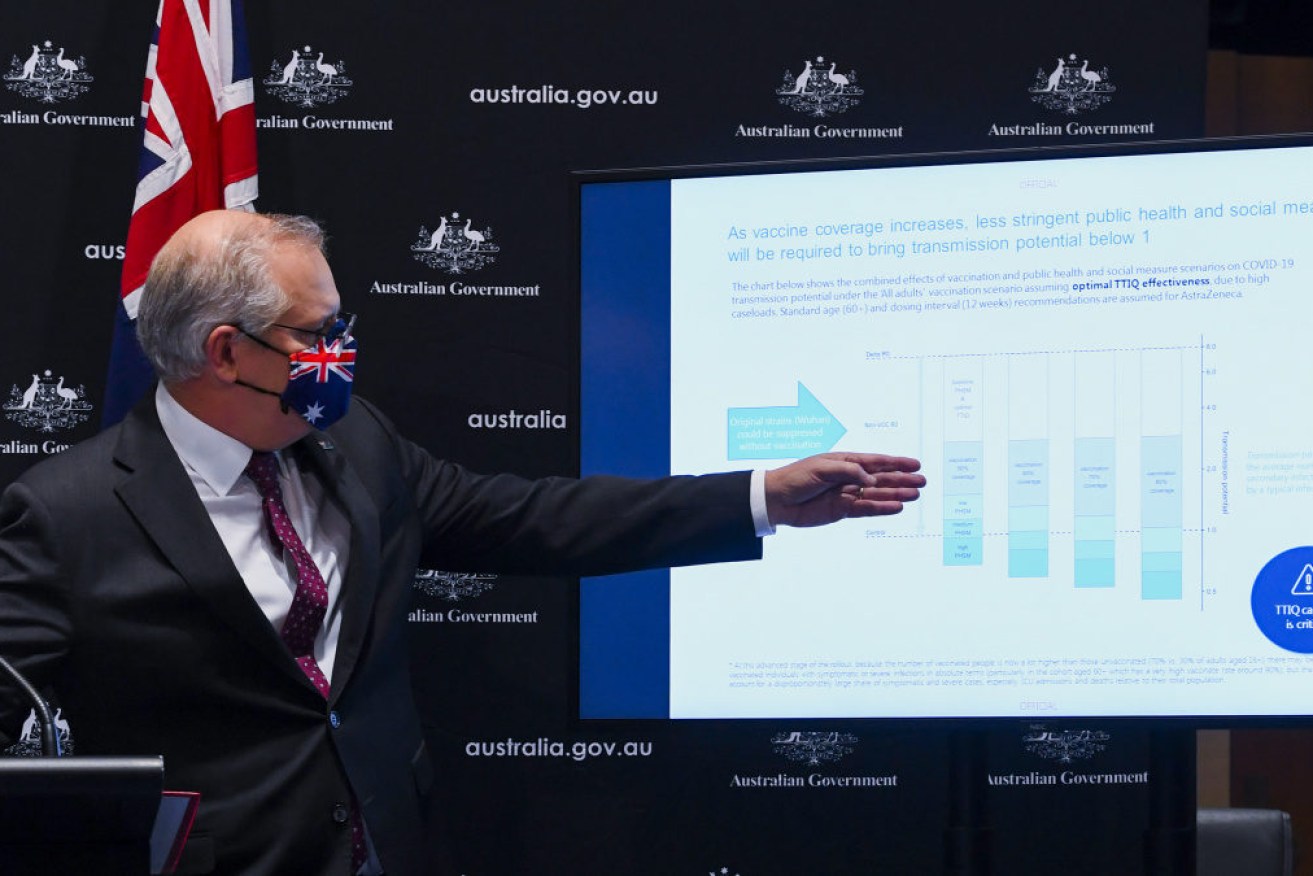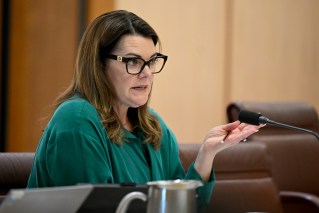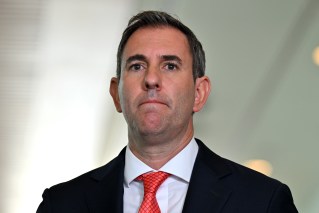Doherty Institute modelling explained: What the NSW outbreak means for reopening Australia


The Doherty Institute's modelling has been the flashpoint for the latest interstate COVID stoush. Photo: AAP
World-leading virus modelling from the Doherty Institute says Australia can only start controlling COVID without lockdowns and border closures when vaccination rates are above 70 per cent of the adult population.
However, the interpretation of these complicated scientific documents is the flashpoint for the latest interstate stoush on the virus, with Scott Morrison once more at loggerheads with several Labor state premiers on how restrictions should be eased.
The Doherty Institute even had to weigh in following all the confusion, with its director giving several lengthy interviews and releasing written statements this week to explain the thinking.
So what’s this latest fight all about? And what does the modelling actually tell us about what happens next?
What’s the Doherty modelling?
National cabinet asked Doherty to set vaccination targets for each phase of the government’s “reopening plan”.
That four-phase plan included hopes of relaxing quarantine for international arrivals, ending domestic border closures and lockdowns, and restarting industries crippled by the pandemic.

Professor Jodie McVernon of the Doherty Institute. Photo: AAP
The plan also sees a shift in policy on the virus, with Mr Morrison asking Australia to move from focusing on “suppression of community transmission” to “prevention of serious illness, hospitalisation and fatality”.
It’s available online here.
What assumptions is it based on?
The Doherty numbers assume:
- The continuation of a “baseline” of “continuous low-level social restrictions” and public health measures, such as minimal density/capacity restrictions
- ‘Optimal’ contact tracing, operating near the peak of NSW’s efforts
- The continuation of case isolation and quarantine.
The modelling says, with ‘optimal’ tracing, testing, isolation and quarantine (TTIQ) and adult vaccination rates above 70 per cent, “high” public health measures (like lockdowns) “would be needed rarely if at all”.
However, crucially for this current political situation, the Doherty modelling also includes assumptions of “a single outbreak involving 30 individuals” when moving to Phase B, once reaching 70 per cent vaccination.
What does it say about deaths and cases?
The modelling shows calculations based on different scenarios and combinations of settings.
If Australia had very high vaccinations and lived under strict public health measures indefinitely, cases and deaths would be lower; if restrictions were eased sooner, numbers would rise.
The modelling shows different combinations of rules, and what effect they would have.

Scott Morrison says Australia shouldn’t “fear” the post-COVID environment. Photo: AAP
For instance, Doherty’s modelling says removing all rules at 70 per cent vaccination, and only keeping “partial” health measures, would see about 400,000 COVID cases and 1500 deaths within six months.
However, that’s not the recommended scenario.
Instead, under the agreed national cabinet plan, Australia would have only about 2700 infections and 13 deaths at 70 per cent vaccinations, if we kept “optimal” public health measures like contact tracing and low-level restrictions.
“That’s the path which we’re pursuing,” Health Minister Greg Hunt said on Tuesday.
“The other alternative is we’re in lockdown forever … And is that really what people are saying?”
What is the latest fight about?
At the centre of this standoff is whether restrictions could be eased when there are hundreds of cases of COVID each day – as currently seen in Sydney – or whether cases need to be lower.
But at the true root of it, is a discussion about whether Australia needs to abandon its unofficial policy of ‘COVID zero’.
Western Australia’s Mark McGowan says he wants to maintain that safe benchmark, while Queensland’s Steven Miles wouldn’t commit to reopening borders to NSW.
Mr Morrison says aiming for COVID zero would be “absurd” in 2022.
Some state premiers are pushing back on the 30 cases a day assumption, saying the modelling never took into account an outbreak the size of that currently in NSW.
The state recorded another 753 cases on Tuesday.
Could restrictions be eased, even with high case numbers?
Yes, according to Doherty Institute director Professor Sharon Lewin.
She told ABC’s The Drum the modelling holds up, no matter the starting number of cases, because cases will rise anyway once restrictions ease.
“Whether you start at 30 cases or 800 cases, you can still open up safely,” Professor Lewin said.
Tweet from @ABCthedrum
On ABC’s PM, she added: “When we open up and accept we no longer have zero COVID, there will be an increase in cases.”
However, opening at higher caseloads puts more strain on contact tracing, potentially lowering its effectiveness below the “optimal” level needed to avoid stricter public health measures.
In essence, opening up at higher cases means tougher public health measures – like lockdowns – could be employed.
“Opening up at tens or hundreds of cases nationally per day is possible, however, we will need vigilant public health interventions with higher case loads,” Doherty’s statement noted.
“We need to keep suppressing COVID-19 through public health measures while we work towards 70-80 per cent vaccination.”
That then returns us to the early pandemic rhetoric of ‘flattening the curve’ of serious illness and hospitalisations, so as to not overwhelm health systems.
It’s why Mr Morrison has been redoubling talk in recent days of needing to use this time, before 70 per cent vaccinations targets are hit, to “plan” and “prepare” hospitals for rising case numbers when restrictions ease.
Labor’s shadow health minister Mark Butler says the government needs to outline exactly what it is doing to beef up tracing and hospital systems, to cope with that surge in cases.
“We need to make sure our tracing, testing and other systems are robust enough to prevent thousands and thousands of additional hospitalisations,” he said.
What does that mean for cases in future?
In short, they will increase.
But as Mr Morrison and the federal government have been stressing, once vaccinations are high, the risk of deaths and serious illness is vastly lowered.
“COVID-19 won’t go away, but it will be easier to control in the future,” the Doherty Institute said in a statement on Monday.
“However, it won’t be possible to maintain a situation where there are no cases at all. The focus will shift to keeping the number of people going to hospital and dying at a minimum.”
This is why you’ve been hearing Mr Morrison urging people “not to fear” the next stage of reopening, and talking about emerging from “the cave”.
“If you open up at tens of cases versus hundreds of cases, we will reach many, many cases of COVID. Hundreds or thousands of cases and some deaths, similar to what we would see with flu,” Professor Lewin said.
“Vaccination will protect people from dying. It will also reduce the risk of transmission.”
This then becomes more a political discussion than a scientific one; namely, how many cases and fatalities is Australia willing to accept, as a trade-off for a more open society?
Lockdowns could continue indefinitely, in order to prevent cases and deaths, but Mr Morrison says this would be “unsustainable”.
What restrictions does Doherty think could be eased?
The main goal is to end lockdowns, but that’s a balancing act against keeping some low-level rules for the foreseeable future.

The various underlying rules Doherty modelled. Photo: Doherty Institute
The “baseline” restrictions in their assumptions include light-touch rules like those in NSW at the start of 2021, including some density and capacity limits.
Mr McGowan said he reserved the right to keep instituting lockdowns.
NSW’s chief health officer Kerry Chant suggested indoor face masks could be a feature of life for years to come.
What happens now?
Vaccinations continue at record pace.
There were 290,000 doses delivered on Monday, taking Australia’s percentage of fully vaccinated people to 30.9 per cent.
Virus data tracker service COVIDLive projects, on current rates, Australia will hit its 70 per cent target within 69 days (by November 1 or thereabouts) and 80 per cent in 87 days (November 19).
That means we still have a lot of time to debate and tinker with the reopening plan.
It also means you’ll be hearing much more about the Doherty modelling before lockdowns end.








